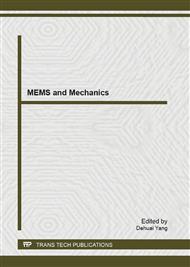[1]
Kumar, M., Verma, A., & Srividya, A. (2009). Response-Time Modeling of Controller Area Network (CAN). Distributed Computing and Networking, 163-174.
DOI: 10.1007/978-3-540-92295-7_20
Google Scholar
[2]
Tindell, K., Burns, A., & Wellings, A. J. (1995). Calculating controller area network (CAN) message response times. Control Engineering Practice, 3(8), 1163-1169.
DOI: 10.1016/0967-0661(95)00112-8
Google Scholar
[3]
Zhong, R. Y., Huang, G. Q., Dai, Q. Y., Zhou, K., Qu, T., and Hu, G. J. 2011. RFID-enabled real-time manufacturing execution system for discrete manufacturing: Software design and implementation. International Conference on Networking, Sensing and Control, Delft, the Netherlands, 11-13 April, pp.311-316.
DOI: 10.1109/icnsc.2011.5874906
Google Scholar
[4]
Dai, Q. Y., Zhong, R. Y., Huang, G. Q., Qu, T., Zhang, T., & Luo, T. Y. 2012. Radio frequency identification-enabled real-time manufacturing execution system: a case study in an automotive part manufacturer. International Journal of Computer Integrated Manufacturing, 25(1), PP. 51-65.
DOI: 10.1080/0951192x.2011.562546
Google Scholar
[5]
Zhong, R. Y., Dai, Q. Y., Zhou, K., and Dai, X. B. 2008. Design and Implementation of DMES Based on RFID. Proceeding of the 2nd International Conference on Anti-counterfeiting, Security and Identification, Guiyang, 20-23 Aug. pp.475-477.
DOI: 10.1109/iwasid.2008.4688433
Google Scholar
[6]
Zhong, R. Y., Dai, Q. Y., Qu, T., Hu, G. J., & Huang, G. Q. (2013). RFID-enabled Real-time Manufacturing Execution System for Mass-customization Production. Robotics and Computer-Integrated Manufacturing, 29(2), 283-292.
DOI: 10.1016/j.rcim.2012.08.001
Google Scholar
[7]
Wang, M. L., Qu, T., Zhong, R. Y., Dai, Q. Y., Zhang, X. W., & He, J. B. (2012). A radio frequency identification-enabled real-time manufacturing execution system for one-of-a-kind production manufacturing: a case study in mould industry. International Journal of Computer Integrated Manufacturing 25(1), 20-34.
DOI: 10.1080/0951192x.2011.575183
Google Scholar
[8]
Huang, G. Q., Qu, T., Zhong, R. Y., Li, Z., Yang, H. D., Zhang, Y. F., Chen, Q. X., Jiang, P. Y., &Chen, X. (2011). Establishing production service system and information collaboration platform for mold and die products. The International Journal of Advanced Manufacturing Technology, 52(9), 1149-1160.
DOI: 10.1007/s00170-010-2762-8
Google Scholar
[9]
Wang, M. L., Dai, Q. Y., Zhong, R. Y., & Huang, G. Q. (2012). RFID-enabled Real-time Mechanical Workshop Training Center. International Journal of Engineering Education, 28(5), 1199-1212.
Google Scholar
[10]
Zhang, Y. H., Dai, Q. Y., & Zhong, R. Y. (2009). An Extensible Event-Driven Manufacturing Management with Complex Event Processing Approach. International Journal of Control and Automation, 2(3), 1-12.
Google Scholar


